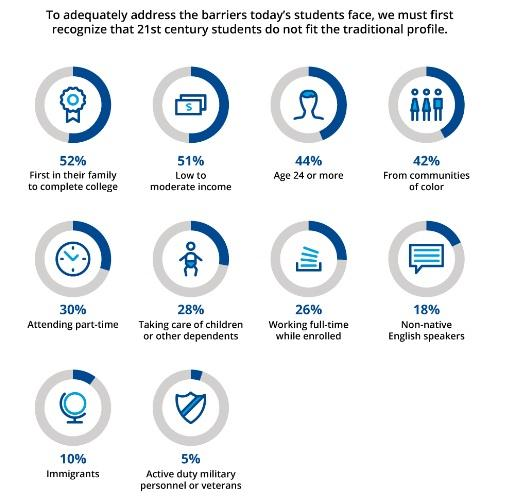8 Secrets of Getting Good Grades in College
In the US, as many as 30% students who enter college drop out after the first year. It was also noted that many students took as many as six years to complete a four-year Bachelor’s degree program.
The profile of first-year students entering the college gates is changing dramatically. Earlier, college students came straight from high school, lived on campus, and attended classes full-time. Today, the student profile of a college looks something like this:

Keeping these things in mind, colleges and universities need to work on student retention sincerely. In this article, we will discuss strategies students can use to improve their grades in college and complete their academic degree programs successfully:
1. Join a Competency-Based Degree Program
If you are a non-traditional student who is juggling college with family and work responsibilities, you might want to join a college with competency-based program models than the traditional credit-hours-based model. Competency-based degree programs reward you for prior experience in the field.
The competency-based programs allow you to learn at your own pace, and attain degrees with the assistance of online courses and proficiency testing.
Some of the universities that are offering competency-based programs are:
- Northern Arizona University,
- Purdue University,
- University of Wisconsin,
- University of Michigan, and
- University of Texas.
2. Take Tips from the Flipped Classroom Learning Model
You can look at the lecture videos, study the material, and complete the suggested activities and assignments before you attend the class, and use the classroom time to reinforce what you have learned or to clear your doubts.
Studies conducted by the Bill & Melinda Gates Foundation reveal that the high-quality hybrid courses that combine classroom time with online learning helps at-risk students to understand and gain expertise in content twice as fast, and increase their pass rates by about 33%.
3. Make Use of Guided-Pathway Learning Model
Florida State University introduced it in the early 2000s, which maps the academic program for students and offers them advice at critical points. The STAR Guided Pathways Systems of the University of Hawaii employs technology to provide a clear, streamlined program to students which allows them to review requirements, explore the scheduling of their classes on time they will take to complete their graduation, and track their progress.
If your university does not offer a similar service, you should take out some time to prepare your own graduation plan – that incorporates short-term and long-term study goals, and the requirements of your program.
4. Look for Academic Support at the Right Place
It has been noticed that American student from the schools in low-income areas have average literacy scores much lower than the OECD (Organization for Economic Co-operation and Development) average, while students from schools in high-income areas achieved the world’s highest literacy scores. It also means that students from poor backgrounds lack the necessary study skills to complete college studies.
Similarly, students who are first in their families to attend a college do not have family or friends to fall back on. If you are facing a similar problem, you can always seek online tutoring services to glide through difficult portions of your class curriculum.
Seeking timely support from the right resource can make a drastic difference to your academic achievement profile. For example, when you are looking for MBA assignment help, consider talking to tutors who have management background or have professional experience in the specialized topic (marketing, HR, finance, etc.) in which you need help.
5. Make Use of Adaptive Learning Platforms
In a typical online class, everyone learns the same content at the same pace – irrespective of their comprehension level or learning style. Adaptive learning technology uses the power of analytics to track the current preparation or expertise level of a student and offers content and study resources best suited to the student in the stage he or she is in at the moment. Complete rates increased in students using adaptive learning platforms by 15%.
Knewton (adopted by Arizona State University in 2011) is one of the tools you can use for the purpose.
6. Know the Difference between Tutoring and Coaching
Tutoring helps you bridge gaps in your knowledge in the specific areas. Coaching is the total support for full college journey. While coaching might be a better option for first-generation college students or students from low-income family backgrounds, most students perform well with peer-led tutoring.
Peer Tutoring Resource Library (PTRL) is an excellent platform for K-12 students, but as a university student, you might want to check out the peer-led team learning program your university offers. You can google for student tutors in your area too or look for subject experts that can teach you online.
7. Look for Flexible Academic Schedules if You are Busy
Many working adults drop out of college because they find it challenging to balance study, work, and family at the same time. They can fulfill both their personal and academic responsibilities if they enroll in institutions that have flexible and student-friendly class schedules.
Some universities schedule blocks in mornings (9 am to noon) or afternoons (2 pm to 5 pm), which are easier to manage for students who have too much on their plate. You might explore these options.
You may also access university support services, such as counseling, library resources, or applying for financial aid, online. For example, John Hopkins University has a provision to advice students on Skype.
8. Best Websites to Use
With so many online education resources available for free, no student should feel helpless or unaided. Some of the websites you may use are:
- ERIC (Education Resources Information Center): This digital library offers you access to the full-text database on education, psychology, and social work.
- Google Scholar: It is a search engine that screens peer-reviewed academic journals, books, dissertations, theses, technical reports, court opinions, and patents for the keywords you enter.
- Grammarly: It is the best grammar coach in the world. It has free and paid tools, which can help you proofread your assignments and broaden your range of vocabulary.
- RefSeek: It only indexes scientific publications, and .edu and .org websites.
- WriteRoom: When you get distracted again and again, and the assignment submission deadline is fast-approaching, try WriteRoom. It has a full-screen writing app with no formatting features and makes you focus only on writing more in less time.
If you want to achieve best grades in college, it is time to take responsibility for your learning. From free YouTube channels to open education resources on almost anything you want to learn, there is no shortage of opportunities for you to evolve yourself and earn best grades in the class. Start now, and be the best that you can be.
Author Bio:
 Rruchi Shrimalli is a Content Marketing Manager for Transtutors.com, and several other websites. She is a writer and a journalist at heart, and has been writing articles on various aspects of the Education domain since 2010. Her articles have been published at Shiksha.com, India.com, and Employment News among others. You can contact her at ruchi@transtutors.com.
Rruchi Shrimalli is a Content Marketing Manager for Transtutors.com, and several other websites. She is a writer and a journalist at heart, and has been writing articles on various aspects of the Education domain since 2010. Her articles have been published at Shiksha.com, India.com, and Employment News among others. You can contact her at ruchi@transtutors.com.




